tow KIA Rio 2005 2.G Owner's Guide
[x] Cancel search | Manufacturer: KIA, Model Year: 2005, Model line: Rio, Model: KIA Rio 2005 2.GPages: 238, PDF Size: 2.6 MB
Page 142 of 238

Driving Tips5-8Rocking the Vehicle
If it is necessary to rock the vehicle to free it from
snow, sand, or mud, move the shift lever of an
automatic transaxle from D (Drive) to R (Reverse) in a
repeat pattern while depressing the accelerator gently.
With a manual transaxle, move the shift lever back and
forth from 1 (First) to R (Reverse).
Do not race the engine. If you are still stuck after a
couple minutes of rocking, have the vehicle pulled out
by a tow vehicle to avoid engine overheating and
possible damage to the transaxle.
✽
NOTICE
Prolonged rocking may cause engine overheating,
transaxle damage or failure, and tire damage.
WARNING - Spinning Tires
Do not spin the wheels especially at speeds
more than 56 km/h (35 mph). Spinning the
wheels at high speeds when the vehicle is
stationary could cause a tire to overheat,
explode and injure bystanders.
When starting from a stop in snow, mud, or sand,
use second gear and accelerate slowly to avoid
spinning the front wheels. Low gear may be used, if
necessary.
Use sand, rock salt, tire chains, or other non-slip
material under the front wheels to provide traction
when stalled on ice, snow, or mud.
WARNING - Downshifting
Downshifting into first gear with a manual
transaxle or into low with an automatic
transaxle while driving on slippery surfaces
can cause an accident. The sudden change in
tire speed could cause the tires to skid. Be
careful when downshifting on slippery
surfaces.
RIO ENG CNA 5.qxd 7/29/05 5:07 PM Page 8
Page 146 of 238
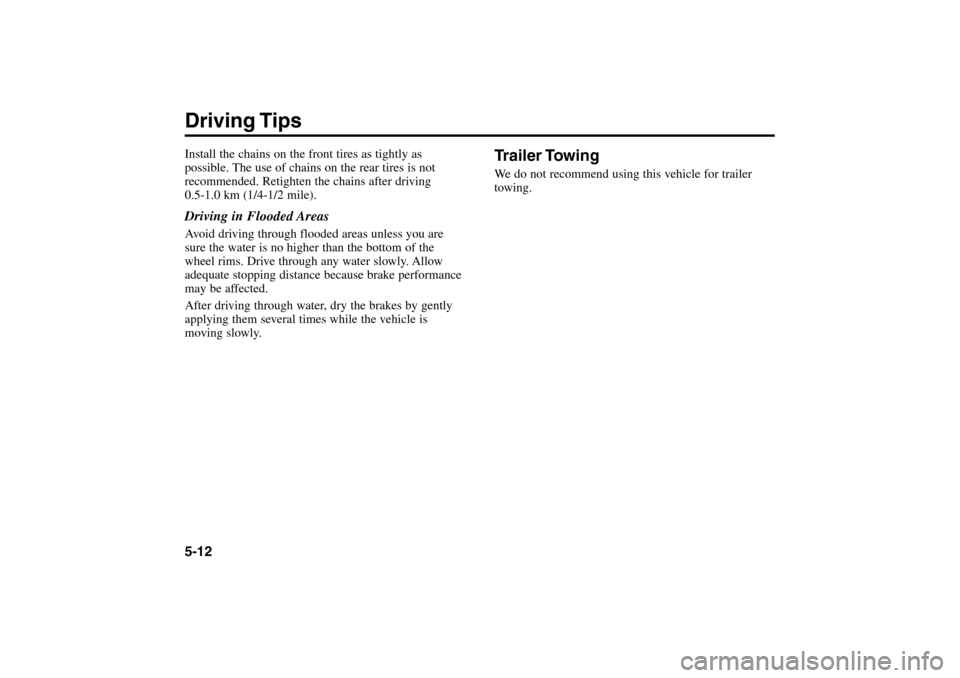
Trailer TowingWe do not recommend using this vehicle for trailer
towing.
Driving Tips5-12Install the chains on the front tires as tightly as
possible. The use of chains on the rear tires is not
recommended. Retighten the chains after driving
0.5-1.0 km (1/4-1/2 mile).Driving in Flooded AreasAvoid driving through flooded areas unless you are
sure the water is no higher than the bottom of the
wheel rims. Drive through any water slowly. Allow
adequate stopping distance because brake performance
may be affected.
After driving through water, dry the brakes by gently
applying them several times while the vehicle is
moving slowly.
RIO ENG CNA 5.qxd 7/29/05 5:07 PM Page 12
Page 150 of 238
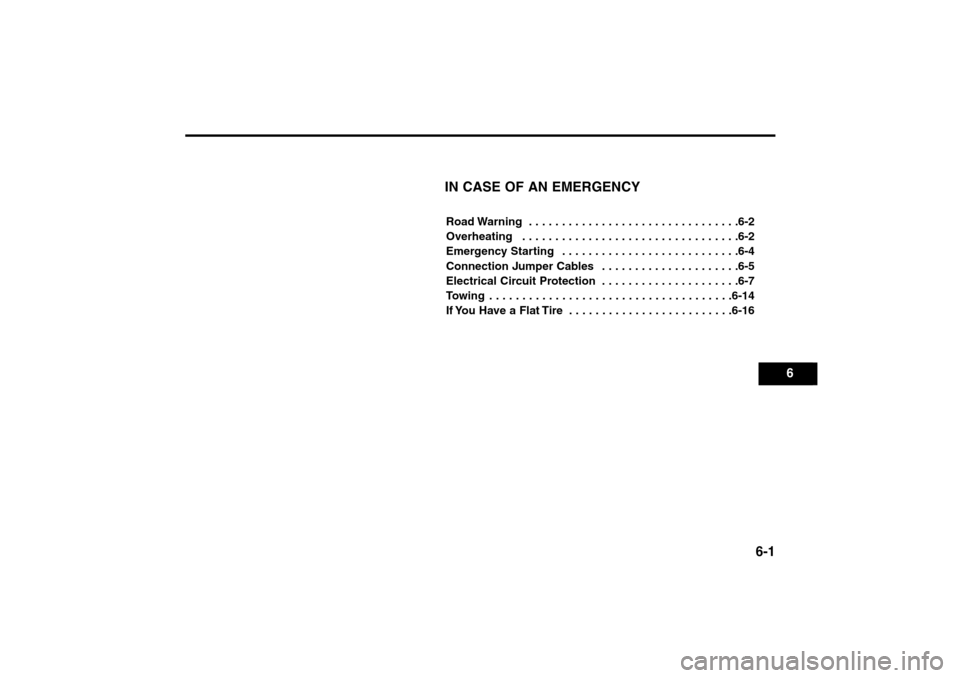
6-1
IN CASE OF AN EMERGENCYRoad Warning . . . . . . . . . . . . . . . . . . . . . . . . . . . . . . . .6-2
Overheating . . . . . . . . . . . . . . . . . . . . . . . . . . . . . . . . .6-2
Emergency Starting . . . . . . . . . . . . . . . . . . . . . . . . . . .6-4
Connection Jumper Cables . . . . . . . . . . . . . . . . . . . . .6-5
Electrical Circuit Protection . . . . . . . . . . . . . . . . . . . . .6-7
Towing . . . . . . . . . . . . . . . . . . . . . . . . . . . . . . . . . . . . .6-14
If You Have a Flat Tire . . . . . . . . . . . . . . . . . . . . . . . . .6-16
6
RIO ENG CNA 6.qxd 7/29/05 5:15 PM Page 1
Page 151 of 238
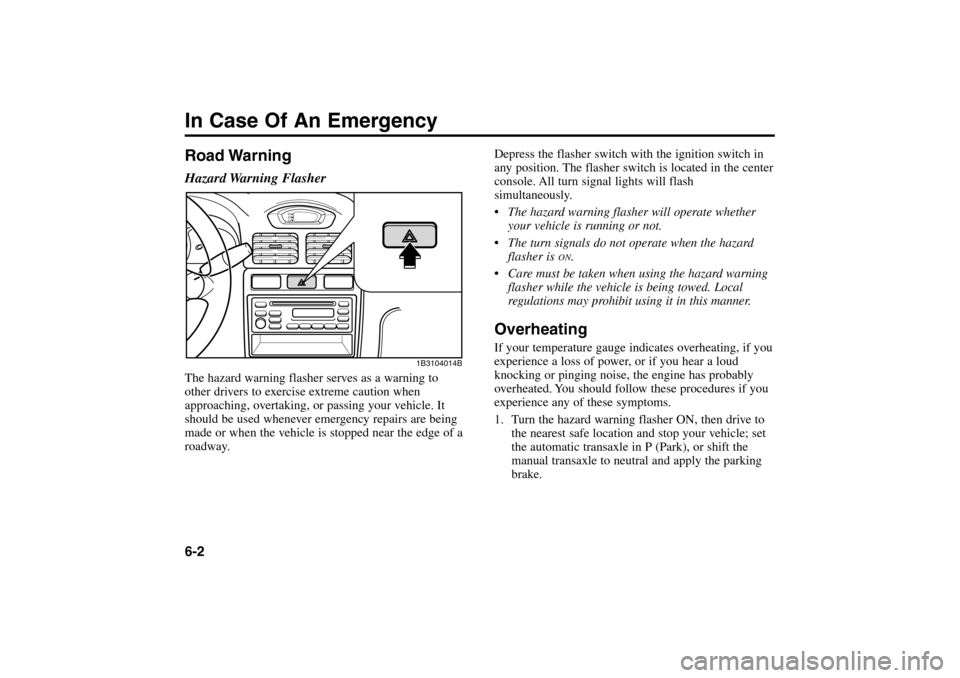
Road WarningHazard Warning FlasherThe hazard warning flasher serves as a warning to
other drivers to exercise extreme caution when
approaching, overtaking, or passing your vehicle. It
should be used whenever emergency repairs are being
made or when the vehicle is stopped near the edge of a
roadway.
Depress the flasher switch with the ignition switch in
any position. The flasher switch is located in the center
console. All turn signal lights will flash
simultaneously.
•The hazard warning flasher will operate whether
your vehicle is running or not.
The turn signals do not operate when the hazard
flasher is
ON
.
Care must be taken when using the hazard warning
flasher while the vehicle is being towed. Local
regulations may prohibit using it in this manner.
OverheatingIf your temperature gauge indicates overheating, if you
experience a loss of power, or if you hear a loud
knocking or pinging noise, the engine has probably
overheated. You should follow these procedures if you
experience any of these symptoms.
1. Turn the hazard warning flasher ON, then drive to
the nearest safe location and stop your vehicle; set
the automatic transaxle in P (Park), or shift the
manual transaxle to neutral and apply the parking
brake.
In Case Of An Emergency6-2
1B3104014B
RIO ENG CNA 6.qxd 7/29/05 5:15 PM Page 2
Page 153 of 238
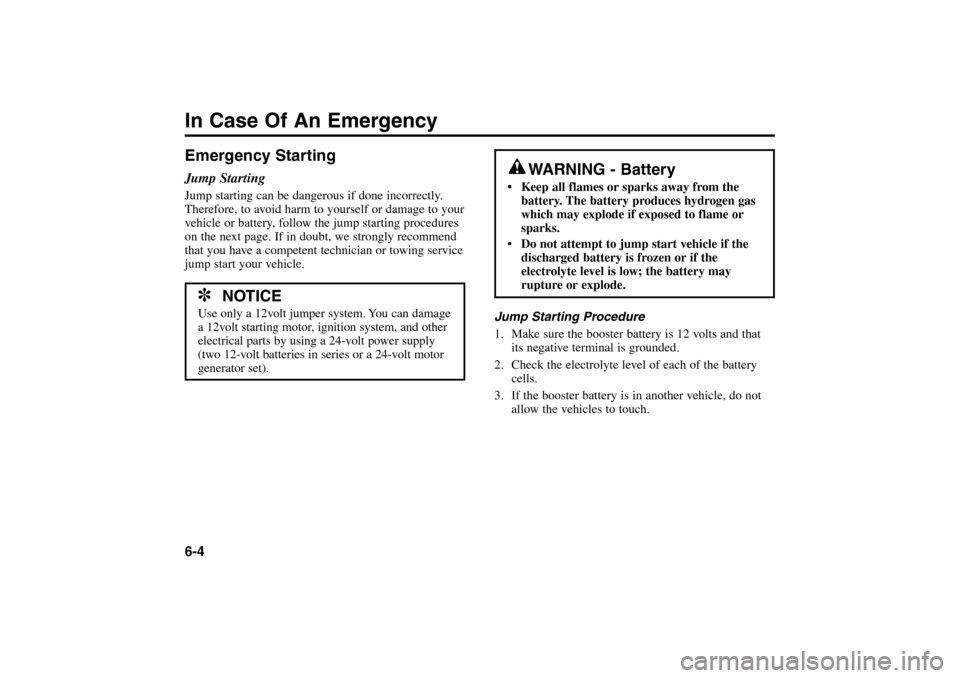
Emergency StartingJump StartingJump starting can be dangerous if done incorrectly.
Therefore, to avoid harm to yourself or damage to your
vehicle or battery, follow the jump starting procedures
on the next page. If in doubt, we strongly recommend
that you have a competent technician or towing service
jump start your vehicle.
Jump Starting Procedure
1. Make sure the booster battery is 12 volts and that
its negative terminal is grounded.
2. Check the electrolyte level of each of the battery
cells.
3. If the booster battery is in another vehicle, do not
allow the vehicles to touch.In Case Of An Emergency6-4
✽
NOTICE
Use only a 12volt jumper system. You can damage
a 12volt starting motor, ignition system, and other
electrical parts by using a 24-volt power supply
(two 12-volt batteries in series or a 24-volt motor
generator set).
WARNING - Battery
• Keep all flames or sparks away from the
battery. The battery produces hydrogen gas
which may explode if exposed to flame or
sparks.
Do not attempt to jump start vehicle if the
discharged battery is frozen or if the
electrolyte level is low; the battery may
rupture or explode.
RIO ENG CNA 6.qxd 7/29/05 5:15 PM Page 4
Page 155 of 238

4. Turn off all unnecessary electrical loads.
5. Connect the jumper cables in the exact sequence
shown in the illustration on the previous page.
First, connect one end of a jumper cable to the
positive terminal (+) of the discharged battery ,
then the other end of the same cable to the positive
terminal (+) on the booster battery . Next,
connect one end of the other jumper cable to the
negative terminal (–) of the booster battery , then
the other end to a solid, stationary, metallic point
(for example, the engine lifting bracket) away
from the battery. Do not connect the jumper cable
to or near any part that moves when the engine is
cranked. Do not connect the jumper cable from the
negative terminal (–) of the booster battery to the
negative terminal (–) of the discharged battery. Do
not allow the jumper cables to contact anything
except the correct battery terminals or the correct
ground. Do not lean over the battery when making
connections.6. Start the engine of the vehicle with the booster
battery and run it at 2,000 rpm. Then, start the
engine of the vehicle with the discharged battery.
If the cause of your battery discharging is not apparent
(for example, having left the lights on accidentally),
you should have your vehicle checked by an Authorized
Kia Dealer.
Push-StartingA vehicle equipped with an automatic transaxle cannot
be started by pushing. A vehicle equipped with a
manual transaxle should not be push-started because it
could damage the emission control system. Follow the
directions for jump starting.
In Case Of An Emergency6-6
CAUTION
Never tow a vehicle to start it. A sudden surge
forward when the engine starts could cause a
collision with the tow vehicle.
1
2
3
4
RIO ENG CNA 6.qxd 7/29/05 5:15 PM Page 6
Page 158 of 238

If the headlights or other electrical components do not
work and the fuses are OK, check the fuse box in the
engine compartment. If a fuse is blown, it must be
replaced.
1. Turn the ignition switch and all other switches off.
2. Remove the fuse box cover by unhooking the tab on
one end, and tilting the cover back toward the other
end.
3. Check the fuses. If one is blown, replace it with a
new one of the same rating.
6-9
CAUTION
After checking the fuse box in the engine
compartment, make sure the cover is properly
reinstalled. An improperly installed cover could
allow water ingress and lead to electrical failures.
2FDA602
RIO ENG CNA 6.qxd 7/29/05 5:15 PM Page 9
Page 163 of 238
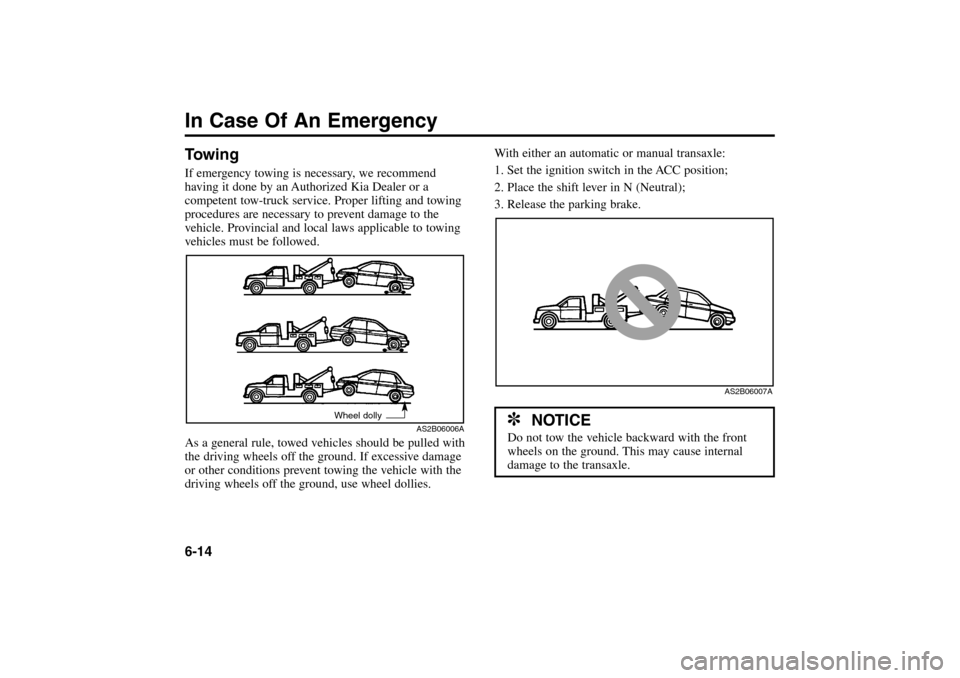
In Case Of An Emergency6-14TowingIf emergency towing is necessary, we recommend
having it done by an Authorized Kia Dealer or a
competent tow-truck service. Proper lifting and towing
procedures are necessary to prevent damage to the
vehicle. Provincial and local laws applicable to towing
vehicles must be followed.
As a general rule, towed vehicles should be pulled with
the driving wheels off the ground. If excessive damage
or other conditions prevent towing the vehicle with the
driving wheels off the ground, use wheel dollies.
With either an automatic or manual transaxle:
1. Set the ignition switch in the ACC position;
2. Place the shift lever in N (Neutral);
3. Release the parking brake.
✽
NOTICE
Do not tow the vehicle backward with the front
wheels on the ground. This may cause internal
damage to the transaxle.
AS2B06006AAS2B06007A
Wheel dolly
RIO ENG CNA 6.qxd 7/29/05 5:15 PM Page 14
Page 164 of 238

6-15
✽
NOTICE
Do not tow with sling-type equipment. Use wheel
lift or flatbed equipment.
CAUTION
Do not use the hooks under the front or rear of
the vehicle for towing purposes. These hooks are
designed ONLY for transport tie-down. If the tie-
down hooks are used for towing, the front/rear
bumper will be damaged and the vehicle may
break free from the tow vehicle.
Tie-Down Hooks (for flatbed towing)
2FDA603/1B3104003C
Front
Rear
RIO ENG CNA 6.qxd 7/29/05 5:15 PM Page 15
Page 168 of 238

6-19 Changing Tires
Jacking Instructions
The jack is provided for emergency tire changing only.
Follow jacking instructions to reduce the possibility of
personal injury.Tire Replacement
1. Park on a level surface and set the parking brake
firmly.
2. Set the automatic transaxle in P (Park), or shift the
manual transaxle into R (Reverse).
3. Activate the hazard warning flasher.
4. Remove the wheel lug nut wrench, jack, jack
handle, and spare tire from the vehicle.
5. Block both the front and rear of the wheel that is
diagonally opposite the jack position.
WARNING - Changing Tires
Never attempt vehicle repairs or a tire
change in the traffic lanes of a public road or
highway. Always move the vehicle completely
off the road and onto the shoulder before
trying to change a tire. If you cannot find a
firm, level place off the road, call a towing
service company for assistance.
Do not exceed the maximum permissible
load of the jack: 600 kg. (1,320 lbs).
Be sure to use the correct front or rear
jacking positions on the vehicle; never use
the bumpers or any other part of the vehicle
for jack support.
Never allow any portion of your body to get
beneath the vehicle while using the jack.
Do not start or run the engine while the
vehicle is supported by the jack.
AS2B06012
Flat tire
Wheel block
RIO ENG CNA 6.qxd 7/29/05 5:15 PM Page 19